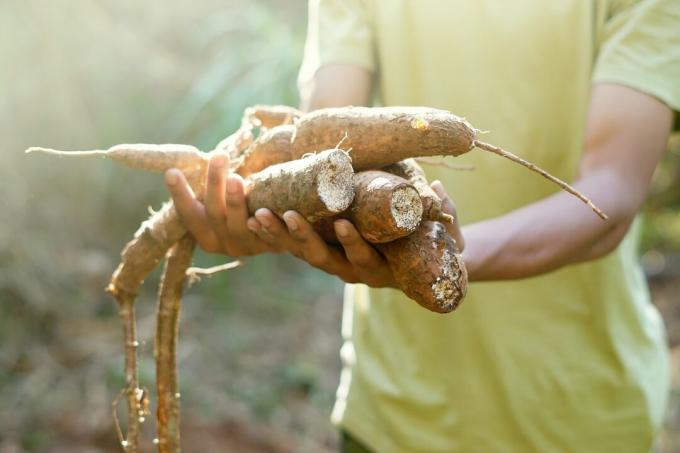The root tuber is an important staple food in many tropical countries. Plantura gives an exciting insight into the world of cassava.

The cassava plant - also known under the names mandioca, cassava or yuca - is now grown in the humid tropical belt around the world - in Latin America, Asia and Africa. Nigerian farmers are the absolute leaders in cassava cultivation. Manioc actually comes from the tropical regions of South America and eventually found its way to other continents as a cultivated plant. The plant has now been cultivated for around 4,000 years.
contents
- Interesting facts about cassava
- Defy climate change
- Use of cassava
Interesting facts about cassava
The cassava, which belongs to the spurge family (Euphorbiaceae), is a perennial shrub that is two to five meters high. Like other spurge plants, cassava has milk tubes running through it. These release a whitish juice when injured. Its silver-grey to brown branches are arranged in a spiral. Below ground, cassava initially forms a kind of taproot, the fibrous side roots of which thicken and form large, spindle-shaped root nodules. It is precisely these starchy tubers that are harvested. These are 30 to 100 centimeters long, 5 to 10 centimeters thick and can weigh up to 15 kilograms. The rather inconspicuous root nodules are wooden and dark brown on the outside and light to reddish on the inside.

What the potato is to us, cassava is to the tropics. As one of the most important and oldest staple foods, cassava feeds up to 500 million people worldwide. Some varieties taste sweet, others rather bitter. The reason for this is the extremely toxic hydrocyanic acid contained in all cassava varieties, which can be neutralized by boiling or drying. Depending on the hydrocyanic acid content, the tubers are divided into sweet and bitter varieties. In addition, the root tuber can show numerous valuable ingredients. These include iron, calcium, phosphorus, potassium and vitamin C. In addition, the cassava tuber is characterized by a very high starch content and is a good supplier of carbohydrates.

Manioc has the great advantage that it can be harvested and exported all year round and not only very high yields with little effort, but that the tubers can also remain in the ground for two to three years without spoil. However, when the tuber is harvested, it must be processed quickly. The harvested roots go bad after 48 to 72 hours. For export, therefore, in addition to cooling, coating with wax is primarily used as a preservation method.
Defy climate change
Fortunately, the cassava plant is undemanding and grows well on poor and acidic soils and in relatively dry climatic conditions. It can withstand heat and drought and needs little or no fertilizer to grow. In addition, cassava enriches the soil with valuable nutrients. This is particularly valuable in relation to the consequences of climate change. Because many farmers in Africa, for example, often have to live with poor harvests due to drought, nutrient-poor soil and irregular rainy seasons. While many useful plants are unable to cope with these climatic fluctuations, the miracle tuber cassava has so far defied the extremes very well.
Use of cassava
Cassava or yucca is still a culinary rarity in our country. In many parts of the world, however, the tuber is an integral part of the diet. The methods of preparation and the number of cassava products vary from continent to continent and from country to country. In South America, for example, the tubers are peeled, ground and soaked. After a few days, the mass is pressed out and roasted in the oven. The cassava flour, also known as farinha, is what remains in the press. This is used to make flatbread, sauces, soups and even alcoholic beverages. Roasted and fried in butter, farinha makes an ideal accompaniment to meat called farofa. Cassava flour can also be used in a similar way to wheat flour and is used as a food substitute in the case of grain allergies. A by-product of the production of cassava flour is starch, which when roasted is also known as tapioca. When crushed, it also makes a popular feed for animals.

It's actually surprising that cassava tubers aren't in greater demand here. Although the vegetables are on the vegetable shelves in some places, almost only culinary connoisseurs buy them. Of course, it always tastes best prepared in the traditional way on site. On your next trip to South America, Asia or Africa you should definitely keep your eyes open for cassava.
At the Jerusalem Artichoke it is also an edible tuber that has been gaining popularity in home gardens for some time. We introduce you to the Jerusalem artichoke and its special features in cultivation and care.
